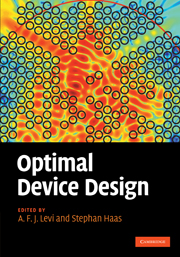Book contents
- Frontmatter
- Contents
- Preface
- Acknowledgements
- 1 Frontiers in device engineering
- 2 Atoms-up design
- 3 Electron devices and electron transport
- 4 Aperiodic dielectric design
- 5 Design at the classical–quantum boundary
- 6 Robust optimization in high dimensions
- 7 Mathematical framework for optimal design
- 8 Future directions
- Appendix A Global optimization algorithms
- About the authors
- Index
- References
8 - Future directions
Published online by Cambridge University Press: 04 May 2010
- Frontmatter
- Contents
- Preface
- Acknowledgements
- 1 Frontiers in device engineering
- 2 Atoms-up design
- 3 Electron devices and electron transport
- 4 Aperiodic dielectric design
- 5 Design at the classical–quantum boundary
- 6 Robust optimization in high dimensions
- 7 Mathematical framework for optimal design
- 8 Future directions
- Appendix A Global optimization algorithms
- About the authors
- Index
- References
Summary
Introduction
The theme of this book is driven by an attempt to exploit system-level complexity that can exist in small devices and quantum systems. The approach adopted involves development of realistic physical models with enough richness in the solutions to allow for discovery of nonintuitive designs. The methodology utilizes a systematic numerical search of solution space to find unexpected behavior. This might include exponential sensitivity, super linearity, polynomial response, or some other desired objective. Obviously, possible future directions of this strategy could be very broad in scope. To narrow the options and help identify a productive path forward it serves to consider some examples that help illustrate the concepts. One way this can be done is by addressing the question of device scaling. That is, what happens when a device is reduced in size.
When electronic and photonic systems are made very small they behave differently. Because we now have access to vast amounts of inexpensive computing power it is possible to find out how these small, but fundamentally complex, systems work, explore differences compared to larger scale systems, and possibly identify opportunities for innovation in the way small systems are designed.
Future directions for research can be guided in part by understanding how small devices and small physical systems differ in their behavior compared to larger systems. One theme that emerges is the increased role fluctuations play in determining the behavior of small complex systems comprising multiple interacting elements. The example of complexity in a small laser diode is discussed in Section 8.2. Another theme is the increased sensitivity scaled devices have to defects and small changes in configuration.
- Type
- Chapter
- Information
- Optimal Device Design , pp. 246 - 261Publisher: Cambridge University PressPrint publication year: 2009



